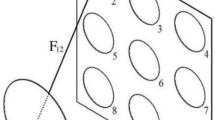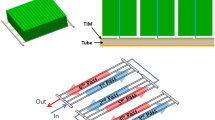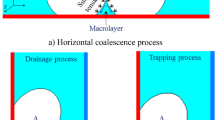Abstract
The ultimate goal of this work is to find the optimal condition for the even distribution of two-phase mixture at header-channel junctions simulating the corresponding parts of compact heat exchangers. The cross section of the header and the channels were 14 mm × 14 mm and 12 mm × 1.6 mm, respectively. Two different distances between channels (10 and 21.6 mm) and four different intrusion depths (0, 1.75, 3.5 and 7 mm) beyond the inner wall of the header were tested for the mass flux and the mass quality ranges of 70–165 kg/m2s and 0.3–0.7, respectively. Air and water were used as the test fluids. The flow distribution pattern was relatively insensitive to the channel distance because the flow configuration inside the header remained almost unchanged. On the other hand, the distribution pattern was changed drastically with the intrusion depth of the channels. The optimum intrusion depth for even flow distribution was identified to be 1/8 of the hydraulic diameter of the header cross-section for the experimental conditions tested in the present work.
Similar content being viewed by others
References
T. Kulkarni, C. W. Bullard and K. Cho, Header Design Tradeoffs in Microchannel Evaporators, Applied Thermal Engineering, 24 (2004) 759–776.
J. K. Lee, Two-phase flow behavior inside a header connected to multiple parallel channels, Experimental Thermal and Fluid Science, 33 (2009) 195–202.
J. K. Lee and S. Y. Lee, Distribution of two-phase annular flow at header-channel junctions, Experimental Thermal and Fluid Science, 28 (2004) 217–222.
P. Hrnjak, Developing Adiabatic Two Phase Flow in Headers — Distribution Issue in Parallel Flow Microchannel Heat Exchangers, Heat Transfer Engineering, 25 (2004) 61–68.
P. Fei, Dj. Cantrak and P. Hrnjak, Refrigerant Distribution in the Inlet Header of Plate Evaporators, SAE Paper 2002-01-0948 (2002) 1397–1402.
D. Zietlow, M. Campagna and J. Dias, Innovative Experimental Apparatus to Measure Liquid Flow Distribution in Two-phase Flow Occurring in the Manifolds of Compact Heat Exchangers, ASHRAE Trans., 108 (2002).
J. K. Lee, Branching of two-phase flow from a vertical header to horizontal parallel channels, Journal of Mechanical Science and Technology, 23 (2009) 1628–1636.
J. K. Lee and S. Y. Lee., Assessment of prediction models for dividing two-phase flow at small T-junctions, Int. J Heat exchangers, 6 (2005) 217–234.
S. Koyama, A. T. Wijayanta, K. Kuwahara and S. Ikuda, Developing Two-Phase Flow Distribution in Horizontal Headers with Downward Micro-Channel Branches, Proceedings of the 11th Int. Refrigeration and Air Conditioning Conference at Purdue, (2006) R142.
N. H. Kim and T. R. Shin, Two-phase flow distribution of air-water annular flow in a parallel flow heat exchanger, Int. J. Multiphase Flow, 32 (2006) 1340–1353.
L. Troniewski and R. Ulbrich, Two phase gas liquid flow in rectangular channels, Chem. Eng. Sci., 39 (1984) 751–765.
Author information
Authors and Affiliations
Corresponding author
Additional information
This paper was recommended for publication in revised form by Associate Editor Yang Na
Jun Kyoung Lee received his B.S. degree in Mechanical Engineering from Busan National University in 1999. He then received his M.S. and Ph.D. degrees from KAIST in 2001 and 2005, respectively. Dr. Lee is currently a Professor at the School of Mechanical Engineering and Automation at Kyungnam University in Masan, Korea. Dr. Lee’s research interests are in the area of two-phase flow and heat transfer, micro-fluidics, cryogenic devices for superconductivity, thermal management system for automobile.
Rights and permissions
About this article
Cite this article
Lee, J.K. Optimum channel intrusion depth for uniform flow distribution at header-channel junctions. J Mech Sci Technol 24, 1411–1416 (2010). https://doi.org/10.1007/s12206-010-0414-4
Received:
Revised:
Accepted:
Published:
Issue Date:
DOI: https://doi.org/10.1007/s12206-010-0414-4




